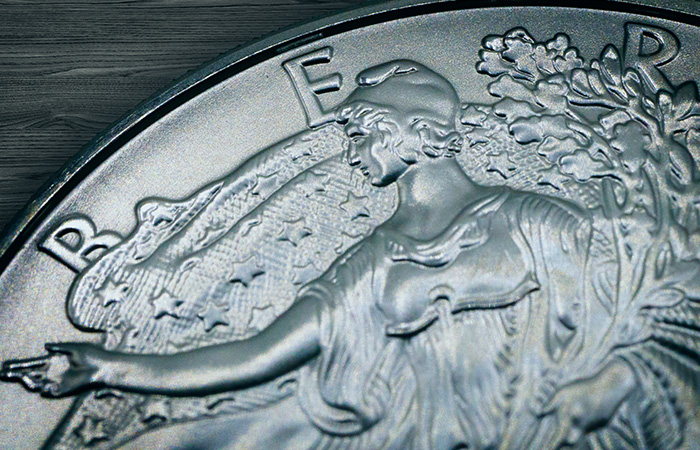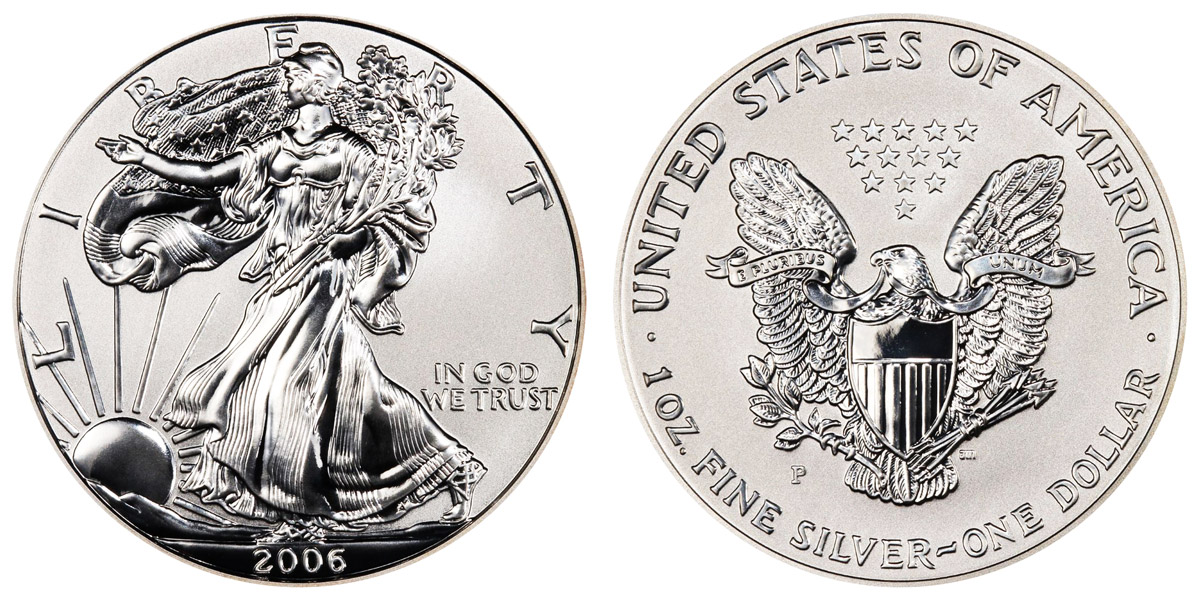Silver Eagle Values - Complete Pricing Guide
The American Silver Eagle (ASE) was first released in 1986 as part of the American Eagle coin program. American Eagle bullion coins were authorized by the Liberty Coin Act signed by President Ronald Reagan in 1985. The first silver eagles were released on November 24, 1986, becoming an immensely popular coin with both investors and collectors from the beginning.

P.S. -- Want to listen to this post?
The American Silver Eagle carries on its obverse design the Walking Liberty design by Adolph A. Weinman, a motif first employed on United States half dollars struck from 1916 through 1947 and brought out of a 39-year retirement to appear on this iconic silver bullion coin. Lady Liberty is dressed in the American flag as she carries an oak branch in her left arm.
Meanwhile, the reverse carries a modern, stylized heraldic eagle by John Mercanti. In one talon the eagle holds an olive branch, and a bundle of arrows is held in its right talon. The design is very similar to the Great Seal of the United States. Inscriptions include the weight of one troy ounce ("1 OZ."), the legal tender face value ("ONE DOLLAR"), A new design for the reverse was first issued in 2021 in honor of the 35th anniversary of the American Silver Eagle series. The obverse side remains the same.
Silver Eagles were first minted from stockpiled silver held by the United States government. In terms of silver content, each ASE is struck from .999 fine silver (99.9% pure silver). Coin prices when you buy American Silver Eagles are close to the silver price, selling for a few dollars above their melt value on the silver market. To buy this silver coin in bulk, a "Monster Box" of 500 coins is available from authorized purchasers.
Types of American Silver Eagles
While the first decade of production saw a relatively staid lineup of ASEs, with conventional bullion quality (formerly called uncirculated Silver Eagles) and proofs struck each year, in 1995 the West Point Mint struck a limited number of proofs for inclusion in the 10th anniversary gold eagle set. The 1995-W silver eagle with the W mint mark was struck as a free bonus inclusion with the anniversary set, and only 30,125 were made. The 1995-W proof quickly became popular with collectors, serving to this day as the rare regular-issue key date to the entire series.
Since the first decade of the 21st century, ASEs have been struck in several other numismatic varieties, including reverse proof, burnished finish, and enhanced uncirculated. Striking duties for bullion-quality pieces originally went to the Philadelphia Mint and early proofs came from the San Francisco Mint. However, minting assignments have changed over the years, with Philadelphia striking proofs for a period in the 1990s and the West Point Mint assuming the vast majority of ASE production by 2000.
Here’s a breakdown of the major types of American Silver Eagles:
Bullion

A pile of Brilliant Uncirculated American Silver Eagles.
The bullion ASEs represent the base-level coins struck with the investor in mind. While they boast high-quality surfaces as is typical for all American Eagle bullion coinage, they are struck in very large numbers and are distributed by the United States Mint through a network of authorized dealers with somewhat less regard for finish preservation than bestowed upon numismatic strikes. They can be purchased for relatively small premiums over the silver spot price.
However, older ASEs are worth a fairly significant figure above spot values, as they are scarcer than more recent issues. Among the most valuable of the bullion-quality strikes are the 1986, 1994, 1995, and 1996, with the latter serving as the key date for all regular-issue bullion strikes.
Proof
The first proof American Silver Eagles were released in 1986 with the debut of the series. They were included in proof sets and struck in all years except 2009, when a planchet shortage reportedly upended production of all non-bullion silver eagle coinage. Regular proofs are relatively common, so some of the earlier pieces are quite rare in grades of PR69 or above. Grading coins is done by third parties such as PCGS and NGC.

Silver Eagle Proof coin | image via USA CoinBook
Reverse Proof
The first reverse proof versions of the American Silver Eagle premiered as a Philadelphia Mint issued strike in 2006 and was made in small numbers.
The proof variety proved a success with collectors, and today the 2006-P reverse proof is relatively scarce due to sustained demand. Several other reverse proofs followed in 2011, 2012, and 2013, and these pieces all remain very popular with collectors; with a mintage of 99,882, the 2011-P reverse proof saw the lowest mintage figures among the four issues and is the most valuable of the reverse proof issues.

Reverse Proof Silver Eagle | image via USA CoinBook
Burnished (Uncirculated)
Debuting the same year as the reverse proof, the first burnished silver eagle was released in 2006 hailing from the West Point Mint. They bear a finish similar to the bullion-quality releases but offer a somewhat matte sheen and are thus desired by coin collectors as a distinct numismatic issue.
Burnished ASEs have been made most years since their debut, with the exceptions of 2009 and 2010, during a period of huge demand for the bullion-quality silver eagles, for which planchets are allocated with utmost priority.

Burnished Silver Eagle | image via USA CoinBook
Enhanced Uncirculated Finish
The first enhanced finish American Silver Eagle was released in 2013, featuring a uniquely frosted, specimen-quality finish. It is a special numismatic offering seldom seen on the ASEs. The United States Mint released its second enhanced finish silver eagle in 2019 with the Pride of Two Nations 2-Coin Set, coupling the 2019-W enhanced finish American Silver Eagle with a 2019 silver Canadian Maple Leaf coin.

Enhanced Finish ASE | image via USA CoinBook
Errors & Varieties
The ASE series offers a few interesting varieties. Perhaps the most popular and valuable of these is the 2008-W Burnished Reverse of 2007. An estimated 47,000 were struck and are worth huge premiums over regular-issue 2008-W Burnished Finish ASEs.
When the relatively few known errors do hit the market, they are typically garden-variety off-center strikes and blank planchets. Indeed, quality control at the United States Mints is quite high with all of its bullion coin programs, including the American Silver Eagle.
Collecting American Silver Eagles
It really goes without saying that the American Silver Eagle program is among the most popular of all bullion coin programs in the world. It’s not the oldest of the modern world bullion series—the gold South African Krugerrand gold coins came in 1967, the Canadian Maple Leaf debuted in 1979, Mexican Libertads were born in 1981, and the Chinese Panda gold bullion program was unveiled in 1982.
But the American Silver Eagle, along with its American Gold Eagle counterpart (and late the platinum and palladium releases) are widely traded both in the United States and abroad and trusted by investors and collectors the world over. They are among the most frequently encountered coins in the precious metals circle.
View the different Silver Eagle product listings available for sale at Gainesville Coins on our category page.

Gold and Silver Eagle comparison.
While numismatic strikes are mainly intended for collectors, a fair number of investors also buy them to add some pizzazz to their holdings. Meanwhile, the bullion-quality ASEs also enjoy converse crossover appeal with collectors, many of whom build date sets spanning from 1986 to the present.
Many collectors pursue all types of ASEs, and the silver eagle registry set collecting objectives set forth by major encapsulation services Professional Coin Grading Service (PCGS) and Numismatic Guaranty Corporation (NGC) compel deep-pocketed collectors to buy super-grade examples in pursuit of the building the highest-quality collections possible.
Silver Eagle Coin Values
Joshua McMorrow-Hernandez is a journalist, editor, and blogger who has won multiple awards from the Numismatic Literary Guild. He has also authored numerous books, including works profiling the history of the United States Mint and United States coinage.
More information from the author before you buy silver:
An Introduction to American Gold Eagles (Including Values)
Most Valuable Kennedy Half Dollars
Walking Liberty Half Dollar Values
